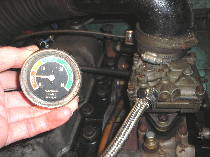
October's Series Land Rover homepage showed how it was possible to use a vacuum gauge to establish that there was reduced engine manifold vacuum. The problem then was to find out the cause of the reduced vacuum.
This month we are looking at using the vacuum gauge to help identify a variety of engine faults.
Ideally the vacuum gauge could be fitted permanently into the dashboard area since Series I, II & IIA Land Rovers have lots of dashboard space available for this. Otherwise, a temporary connection may be made at the carburettor vacuum outlet or, if fitted, the brake servo vacuum connection (a short length of wide diameter rubber pressure tuning and a reducing connector will be needed for this). Either way, it is essential that got airtight connections are made at the gauge end and the vacuum source end.
The standard vehicle vacuum gauge measures vacuum in inches of mercury. Normal steady vacuum readings on various petrol engines at idling speed can range from 17 to 22inches. It should be noted that engine vacuum is reduced by about 1 inch per 1,000ft(325m) altitude so allow for this if you are at altitude.
LOW, but steady reading
i.e. below 17inch. This suggests late ignition timing or incorrect valve timing. Other possible causes are leakage around the pistons, due to stuck piston rings, or worn rings, pistons or walls. Unless your Series Land Rover engine has been rebuilt then it is likely that the vacuum will be reduced below normal 17-22inch range.
VERY LOW reading
This suggests a leaky carburettor gasket or intake manifold leak. Another possible cause is due to air leaks around a worn carburettor throttle shaft.
OSCILLATIONS of the needle
If the oscillations increase with engine speed then this indicates weak valve springs.
GRADUAL FALLING BACK of needle towards zero
If the needle gradually falls back towards zero whilst the engine is idling then this is an indication of a blockage in the exhaust system. The most likely location is in the silencer and would be due to corrosion debris probably. It is possible to get stainless steel silencers for Series Land Rovers.
REGULAR DROPPING BACK of needle
A periodic dropping back of the needle suggests a sticking valve or a spark plug that is not firing.
This a a fault that would be harder to diagnose without the aid of a vacuum gauge.
IRREGULAR DROPPING BACK of needle
If the needle drops back on an irregular basis then it suggests valve sticking in an irregular way.
Again hard to diagnose without the gauge.
FLOATING OR SLOW OSCILLATION of needle
This is a sign of an over-rich fuel/air mixture. Also indicated by a black powdery deposit in the tailpipe.

************************
(To see previous homepages visit the Homepage Archives link)
**************************
![]() Back
to top
Back
to top

